|
SAMARKAND, CAPITAL of TIMURIDS
The greatest hero in Mongolian history is Chinggis (Genghis) Khan (1167-1227). He unified Mongolia in the 12th century and became a Khan (great sovereign in a nomadic land). Marauding from Khwarazm to West Asia, and even into Eastern Europe, he plunged each regionfs peoples into an abyss of terror through devastating massacres. After his death, the Mongolian army destroyed the long-lived Abbasid Dynasty in Baghdad in 1258.
The Islamic world in the Middle East was completely wrecked by this event, and yet it would suffer another severe disaster a century later. Timur (Tamerlane, 1370-1507) would unite the fragmented Chinggis Khanfs empire in the late 14th century, establishing the Timurid Dynasty in Central Asia. He also invaded the Middle East, Russia, India, and so forth, massacring each regionfs peoples once again.
However, differing from his predecessor, after the fierce destruction, he gathered a multitude of literary men, scholars, architects, and artists in every region to bring back to his great empirefs capital, Samarkand, in order to construct and beautify all kinds of buildings and promote culture and learning in an unprecedented scale.
As works of architecture, the enormous Bibi Khanum Mosque (1405) and the Gur-e Amir Mausoleum (1405), Timurfs own tomb, are celebrated, looking as if Persian art was transferred to Central Asia.
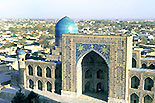 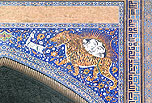
Looking down of Tilla Kali Madrasa & Wall mozaics of Shir Dar Madrasa
eKOSH,f TECHNIQUE on URBAN DESIGN
What is noteworthy in the cities in Central Asia, such as Samarkand, Bukhara, and Khiva, is that building complexes play important roles in city planning, though in a different way from those in Turkey. Since they were not necessarily planned from the beginning, it might be better to call them discrete urban design in respective stages rather than an established planning method.
The process is as follows: at the construction of an important edifice in a city, an architect considers the relationship with existing buildings to be quite important, creating a common axis penetrating them or making up a square between them, as if the complex was formed as such from the start as regional planning.
This technique is referred to as eKosh,f which means ea couplef in Uzbek, because it was often applied to two buildings facing one another across a street.
The largest example of this system is the Registan Square in Samarkand, where three Madrasas face each other around the square. As a result of its grand scale, it has formed the most magnificent cityscape in Central Asia.
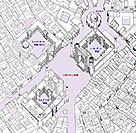 ISOMETRIC of Registan Square
ISOMETRIC of Registan Square
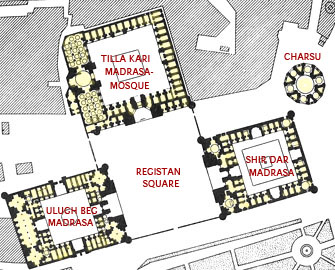 PLAN of the Registan Square, Samarkand
(From "Beyond the Oxus" by Edgar Knoblock,1972, Ernest Benn)
PLAN of the Registan Square, Samarkand
(From "Beyond the Oxus" by Edgar Knoblock,1972, Ernest Benn)
The Registan, which literally means ea sandy place,f might have been an area where an erstwhile brook had accumulated sand and silt. The main square in each city used to be called Registan and became a square for Bazaars, a stage for the kingfs proclamations, and a venue for all sorts of festivals, as with the Royal Square in Isfahan.
The Registan in Samarkand was expanded during the age of Timur to be the center of commerce and industry. Then his grandson, Ulugh Beg, constructed a grand scale Madrasa and a Khanqah (monastery for Sufis) facing each other in 1420.
Ulugh Beg himself was a scientist and astronomer and encouraged learning, constructing a Madrasa crowned with his name in Bukhara, as well. Afterward, a caravanserai and a mosque were built in the square, but the area declined in the 16th century. The governor of Samarkand, Yarlangtush, began to reconstruct the complex by means of the Kosh system, the Shir Dar Madrasa at the site of Ulugh Begfs Khanqah and the Tilla Kari Madrasa at the former caravanseraifs site, forming the current magnificent square.
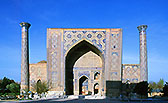 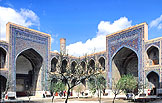
Ulugh Beg Madrasa
OSTENTATIOUS ARCHITECTURE
Each Madrasa took the form of Four Iwans and held about a hundred boarding students. On the Makka side, there is a worship room, of which the Tilla Kari (meaning eclad with goldf) Madrasafs is particularly large and brilliantly decorated with gold leaf, from which the name is derived.
The Bibi Khanum Mosque, which had been erected by Timur, was too enormous to maintain sufficiently, and was left dilapidated half in ruins, so a new mosque was needed in the center of Samarkand. In order to fill that demand, the Tilla Kari was used as a Friday mosque in addition to being a Madrasa.
 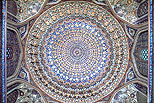 
Mihrab and Ceiling of Tilla Kari Madrasa-mosque
Although the great Registan Square is surrounded with the large Iwans of the three Madrasas, it differs from the Royal Square of Isfahan, Iran. It can be said that the buildings of the Registan turn outward in an exhibitive manner, in contrast to the latter, which has an introverted character like a open courtyard despite its enormousness.
Persian architecture sought visual value more than Arabic architecture did, and yet the architecture of Central Asia was willing to express its external majestic appearances even further.
(In "Architecture of Islam" 2006)
|